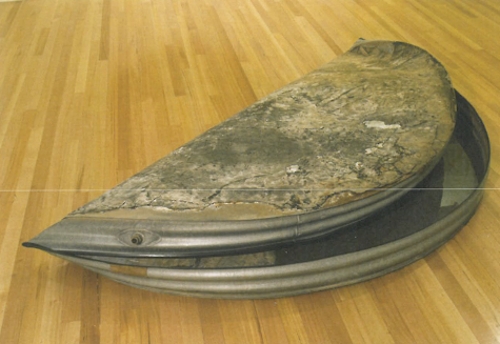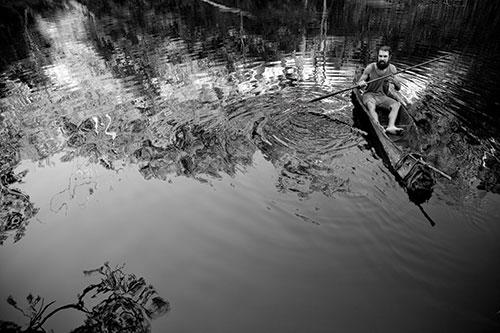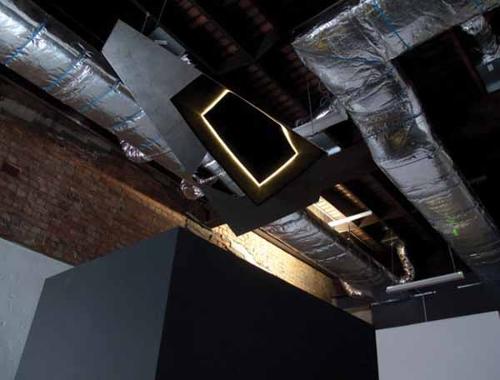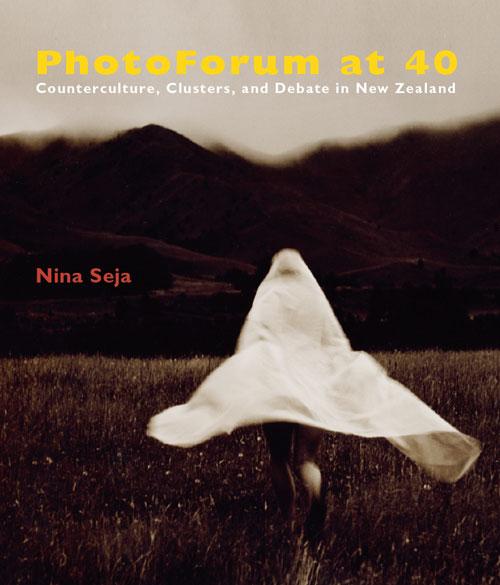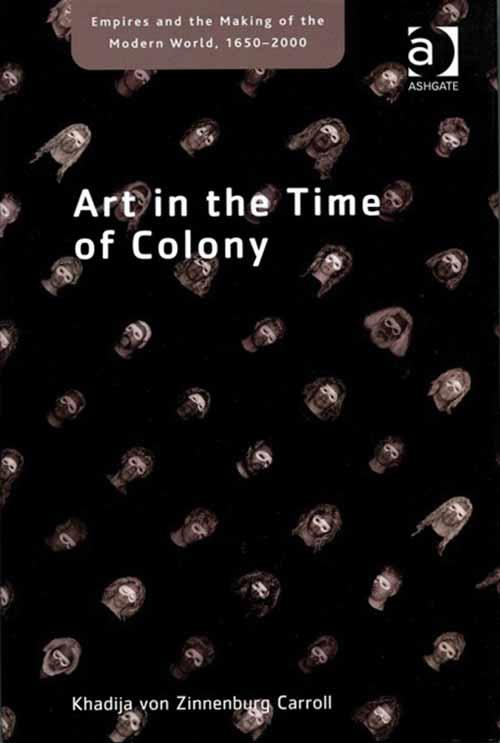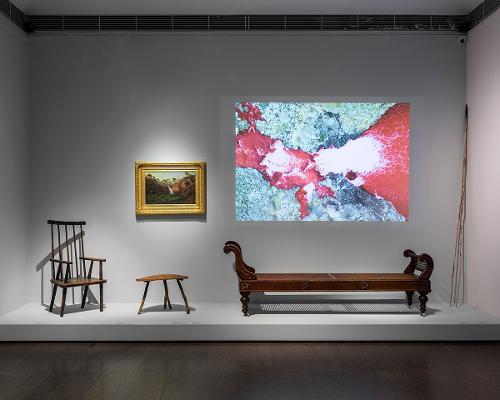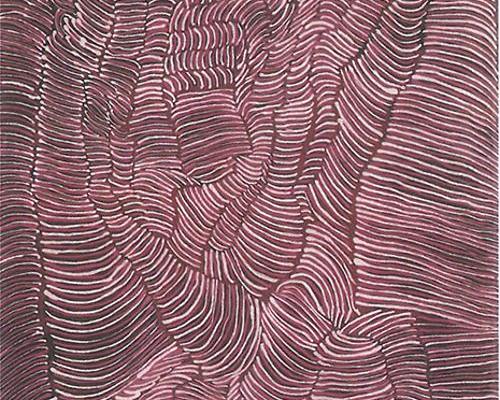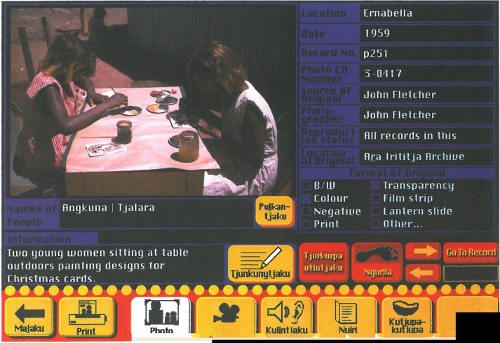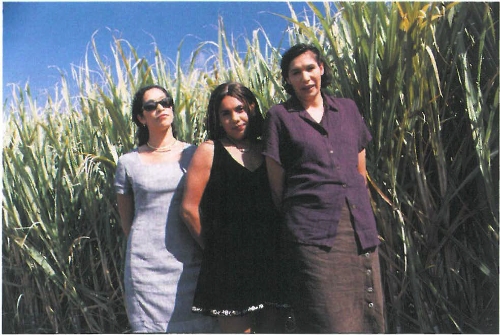Search
You searched for articles tagged with First Nations ...
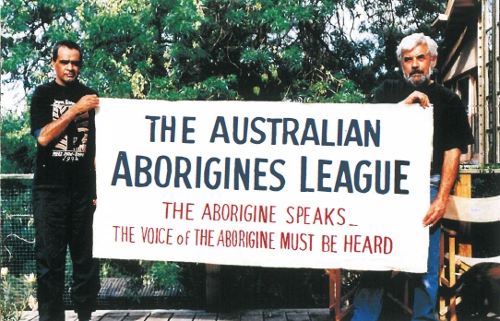
Lin Onus
Lin Onus had a remarkable career, from motor mechanic and political activist to maker of marvellous, witty and original paintings and sculptures. He was also widely loved and respected for his compassion and willingness to lead the cause of Aboriginal advancement.
The Land made Visible: Native Title Now
Written with Vincent Megaw. Looks at land claims and the role of artworks in these claims in the context of the exhibition 'Native Titled Now' shown as part of the Telstra Festival of Arts 1996. Good overview of indigenous art practice and talks about artists such as Raymond Arone Meeks, Lin Onus, Gordon Bennett, Alice Hinton-Bateup, Avril Quaill, Kerry Giles, Daphne Naden, Mick Namarari, Turkey Tolson, Danie Mellor, Jonathan Kumintjara Brown, Clifford Possum, Ellen Jose, Lindsay Bird Mpetyane, Heather Shearer and Kathleen Wallace.
Indigenous Arts of the Pacific
An Alternative to the Art Market
The market must acknowledge its role in the commidification of indigenous cultures through cultural objects....What the market must acknowledge is the relationship of interdependency which exists between itself and the artists that it promotes and as such, the market must ensure that its actions do not prove detrimental to the artist and the community in the long run.
Indigenous Arts of the Pacific
Tandanya - Captivating Culture
Brief overview of the current focus of Tandanya the National Aboriginal Cultural Institute in Adelaide, South Australia.
Indigenous Arts of the Pacific
New Developments for the Papua New Guinea National Museum
Brief article outlining the current directions and focus for the PNG Museum and Art Gallery in Port Moresby.
Indigenous Arts of the Pacific
Art is Land: Land is Art - Talks with Banduk Marika
Discussion with the artist Banduk Marika about the issues facing her community of Yirrkala in Arnhem Land, Northern Territory. Indigenous art practice and land rights, cultural heritage, education and knowledge, environmental protection and mining intrusions are discussed.
Indigenous Arts of the Pacific
The Waka and the Cattle Truck
What do a traditional Maori canoe (waka) and a cattle truck have in common?...In both these cases these vehicles were conveyors of culture. These images are central to two collaborative works at the second Asia Pacific Triennial of Pacific Art at the Queensland Art Gallery.
Indigenous Arts of the Pacific
Pacific Wave: A Festival of Pacific Arts
Brief article outlining Pacific Wave, a celebration and investigation of contemporary trends in art and cultural life of the Pacific taking place across Sydney November 2-17 1996.
Indigenous Arts of the Pacific
Nucleus: Feeling Compromised
As Judy Watson was about the commence her residency in France, the French Government announced they would be conducting nuclear tests in the Pacific. As an Australian, an Aboriginal, a conservationist, a woman and an artist, she felt compromised. Discusses her work in this context.
Indigenous Arts of the Pacific
Maori Film Images and Intellectual Property Rights - A Breakthrough?
For those depositing films with a significant Maori content, the New Zealand Film Archive has developed a Deposit Agreement which acknowledges that named Maori guardians have spiritual guardianship authority over their image treasures in perpetuity. This goes way beyond white copyright regimes.
Indigenous Arts of the Pacific
Contemporary Maori Architecture - The Case for the Untraditional
One of the most insidious myths about contemporary Maori architecture is that it does not exist, since 'traditional' Maori building design has been influenced by colonial architecture. Looks at contemporary issues in Maori architecture.
Indigenous Arts of the Pacific
Taki Rua: Bi-cultural Theatre in Aotearoa
Taki Rua Theatre has been at the cutting edge of indigenous theatre since its inception in 1983. It has now produced a season of Maori plays in te reo Maori (Maori language).
Indigenous Arts of the Pacific
Telling it How it is: Pacific Islands Theatre in Aotearoa New Zealand
Pacific Islands Theatre is at an exciting phase in New Zealand. Although relatively young compared to Maori and Pakeha theatre, the debut of key successful plays has placed it in the spotlight of New Zealand's national stage in recent years as it continues to gain strength.
Indigenous Arts of the Pacific
The Art of Survival: The Importance of Contemporary Theatre in Papua New Guinea
In many developing countries where indigenous communities are faced with the rapid process of development, theatre has become an extremely important educational tool. With escalating resource exploitation, rising numbers of sexually transmitted diseases and AIDS and increases in violent crimes by an unemployed and disillusioned youth, the importance of this form of communication cannot be underestimated.
Indigenous Arts of the Pacific
Polynesian Tattoo: A Shift in Meaning
Tattoo played a significant role as a marker of status, wealth, and pride in Polynesian societies. A more fluid, creative tattoo tradition is being practised today.
Indigenous Arts of the Pacific
Creativity in the Forest
In 1994, the small Balai community of Malaita Province, Solomon Islands, commenced paper making which led to the development of printmaking. Small enterprises and ecotourism may well be the future of these small island communities.
Indigenous Arts of the Pacific
Spirit Blong Bubu I Kam Bak [The Return of the Spirits of the Ancestors]
Reflections on an exhibition in Vanuatu of old pieces of ni Vanuatu art held in European collections. Touring Exhibition 'Arts of Vanuatu' 29 June - 10 August 1996 at the National Museum of Vanuatu in the national capital of Port Vila.
Indigenous Arts of the Pacific
The Contemporary Highland Shield: Hybrid Forms in Papua New Guinea
The author examines shield collected in 1995 to discuss issues fundamental to the introduction of the art of emergent societies in an international art context. Issues such as the definition of art and aesthetics, art versus craft, function of art in the various contexts etc...
Indigenous Arts of the Pacific
Oceanic Arts Society of Sydney
Describes the establishment and membership of this new society.
Indigenous Arts of the Pacific
Acting Out the Culture: The Making of Culturally Relevant Theatre, Papua New Guinea
Culturally relevant theatre in education in Papua New Guinea challenges, questions, asserts, transgresses, subverts, opposes, resists and negotiates with the demands of political and cultural relations. It offers new forms of representation and contributes to the process of destabilising and decentering the domination of Western processes of teaching, learning and performance.
Indigenous Arts of the Pacific
Art and Ritual: Aina Asi A Mavaru Kavamu
The artist writes of the issues facing her as a citizen of Papua New Guinea, a descendant of the Motu Koita people, being female and an artist/textile designer. Her traditional grass skirts were included in the Asia-Pacific Triennial.
Indigenous Arts of the Pacific
Weaving the Old with the New: Textile Art Forms in Niugini
Women artists were conspicuously absent from the important exhibition 'Luk Luk Gen'. The exhibition 'Pacific Dreams' included textile works by the artist Agatha Waramin who works with bilums and the exhibition 'Weaving the Old with the New' will extend women's exposure in an artistic context.
Indigenous Arts of the Pacific
Dancing the Society: Performing Arts in the Solomon Islands
Performing arts in the Solomon Islands Since the common determining facts in whether to keep, add changes, or reject aspects of the performing arts are based on the dollar, Solomon Islanders will continue to adopt new styles of dances, music, songs and forms of acting in the same way as some Church groups have done.
Indigenous Arts of the Pacific
Educating Public Taste
The National Museum's role in the development of contemporary art in the Solomon Islands. Artists Dick Taumata, Kuai Maueha, Frank Haikiu, Rex Mahuta, Jack Saemala and Billy Vina are discussed.
Indigenous Arts of the Pacific
Pacific Stories from New Caledonia
Collecting Pacific Art is not a straight forward endeavour. There are really no set criteria of what 'contemporary Pacific art' might be, little interpretive literature on the subject and very few precedents for forming even small collections for cultural institutions. There is a new cultural centre 'the Jean-Marie Cultural Centre' being built in Noumea, New Caledonia.
Indigenous Arts of the Pacific
Soapstone Workshop
April 1996 at the Pouebo Town Hall northern New Caledonia. A sculptural tradition has always been alive in this area so a workshop was held to explore the use of soapstone sculpture.
Indigenous Arts of the Pacific
The Island Race in Aotearoa
Today the art of the Pacific Islanders is still trapped within its category. The display cases of the institutions have not been shattered. Yet the very act of exhibiting demonstrates that the making and the appreciation of art is a dynamic process. Institutions are caught by a need to both legitimise themselves and acknowledge (and perhaps attempt to control) the art of the migrant communities.
Indigenous Arts of the Pacific
Vaka - Only the Brave
Looks at the contemporary art and the cultural and economic pressures faced by the people of the Cook Islands.
Indigenous Arts of the Pacific
Fiji: Artists Carve Out Their Own Future
Looks at issues in contemporary art practice in Fiji anticipating the construction of the new Fiji National Art School.
Indigenous Arts of the Pacific
Asia and Oceania Influences - Sydney
Exhibition review Asian and Oceania Influence
Curated by Nick Waterlow
Ivan Dougherty Gallery, Sydney
2-30 September 1995
Indigenous Arts of the Pacific
The World Over - Wellington
Exhibition review The World Over
City Gallery Wellington, New Zealand
June 8 - August 11, 1995
Indigenous Arts of the Pacific
Australia Goes to Samoa: 7th Pacific Festival of the Arts
Overview of the 7th Pacific Festival of Arts which is held in a different country every 4 years. 1996 the festival was held in Apia in Western Samoa. Previous hosts 1992 Raratonga, Cook Islands 1988 Townsville Queensland Australia Lists the communities of Aboriginal Australians who were in attendance at the festival.
Indigenous Arts of the Pacific
Alternative Festival in Samoa
An alternative festival celebrating the people of the Pacific was held on one of the outer islands (Manono) in Western Samoa at the same time as the official Pacific Festival of the Arts in Apia. The festival was conducted from 8-23 September 1996.
Indigenous Arts of the Pacific
Collaboration - Zhou Xiaoping and Jimmy Pike
Chinese Australian artist Zhou Xiaoping and Aboriginal artist Jimmy Pike exhibit collaborative works in China later in 1996. The author discusses Zhou's new work and his collaboration with Jimmy Pike.
Indigenous Arts of the Pacific
The Necessity of Craft ed Lorna Kaino
Book review The Necessity of Craft: Development and Women's Craft Practice in the Asian Pacific Region
Edited by Lorna Kaino
University of Western Australia Press 1995
RRP $24.95
Indigenous Arts of the Pacific
Encyclopaedia of Aboriginal Australia ed David Horton
Book review Encyclopaedia of Aboriginal Australia with companion CD Rom
Edited by David Horton
Aboriginal Studies Press for AIATSIS
RRP $150
Indigenous Arts of the Pacific
Doin' the Limbo
Exhibition review White Hysteria
Curated by Susan Treister
Contemporary Art Centre, Adelaide South Australia
7 - 30 June 1996
Indigenous Arts of the Pacific
Whetting the Appetite
Exhibition review State of the Art 4 Biennial survey exhibition
curated by Stephanie Radok
New Land Gallery, Port Adelaide South Australia
21 April - 12 May 1996
Indigenous Arts of the Pacific
The Silence which Howls
Exhibition review Second Look: Prospect Textile Biennial
Prospect Gallery
14 April - 5 May 1996
Indigenous Arts of the Pacific
Funk Junk
Exhibition review Junk Bonds
New Land Gallery, Port Adelaide South Australia
Touring South Australia and interstate with Visions of Australia
28 June - 28 July 1996.
Indigenous Arts of the Pacific
Truth, Whose Truth?
Exhibition review Peter Dailey: Prime Time
Lawrence Wilson Art Gallery
University of Western Australia
17 May - 30 June 1996
Indigenous Arts of the Pacific
Memories - Macabre and Magic
Exhibition review Aadje Bruce: Domestic Bliss
Artplace Claremont Western Australia
9 May -1 June 1996
Indigenous Arts of the Pacific
Resilient Modernism
Exhibition review Miriam Stannage and Tom Gibbons
Goddard de Fiddes
Contemporary Art Perth, Western Australia
2- 22 June 1996
Indigenous Arts of the Pacific
From the Back Shed
Exhibition review House and Home
Anne Neil and Steve Tepper
Fremantle Art Centre galleries,
grounds and craft shop
25 May - 16 June 1996
Indigenous Arts of the Pacific
Neo-colonialist Precipice
Exhibition review Secret Places
Sieglinde Karl, Hazel Smith, Kate Hamilton, Ron Nagorka
Queen Victoria Museum and Art Gallery,
Touring regional Australia through Contemporary Art Services Tasmania and the national Exhibitions Touring Scheme.
Indigenous Arts of the Pacific
Touch Don't Touch
Exhibition review Tangibility
Claire Barclay, John R Neeson, Stephen Bush & Jan Nelson Plimsoll Gallery and Powder Magazine, Hobart
10 - 31 May 1996
Indigenous Arts of the Pacific
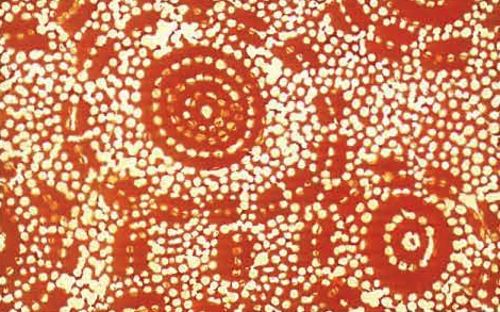
Polemic: From the 21st Century and Through the Telescope
Polemic: There has been a paradigm shift in Australia with the development of Aboriginal art, which may be as consequential as that of the Impressionists. Over the last 30 years Aboriginal artists have been making their voices heard and now make up at least 25% of the country's working visual artists though they are only 1.7% of the population. Their art will go down in history as providing new perspectives with which to view the world
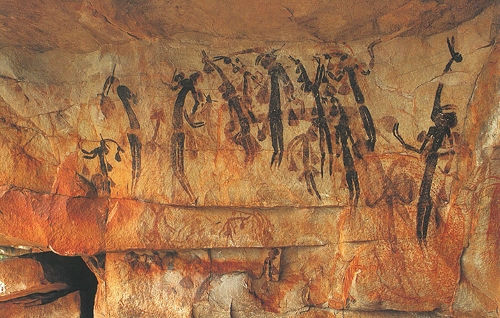
New insight into old North Australian Rock-Art
The rich rock art of Australia, especially of Arnhem Land and the Kimberly continues to be the subject of research, as well as fierce debate about their meaning and age, with obvious implications for Aboriginal cultural history. Three signficant styles are identified : the 'Bradshaws', (named after explorer Joseph Bradshaw who discovered them in the 1800s) the 'Dynamic' and the 'Wanjina' paintings. Most of the more than 100,000 ancient sites are not effectively protected but are of great importance to living Aboriginal people.
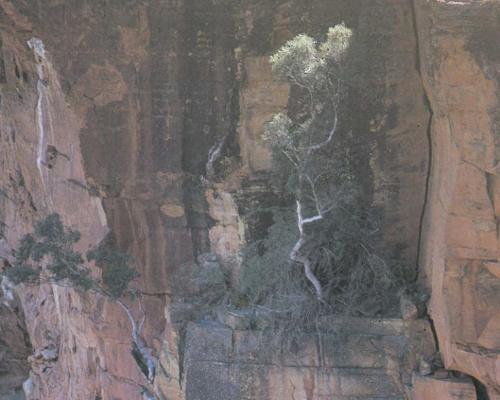
Homeland: Sacred Visions and the Settler State
In spite of supporting a vast artworld of curators, critics and collectors, the 'otherness' of Aboriginal art in the Western canon persists, fuelled by white settler reluctance to acknowledge history. The valorisation of the life and work of Emily Kame Kngwarray is one of the great imponderables of our time. Her extreme age, traditional origins, style of painting and prodigious output were the causes. Most significantly she demonstrated the possibility of human intimacy with landscapes.
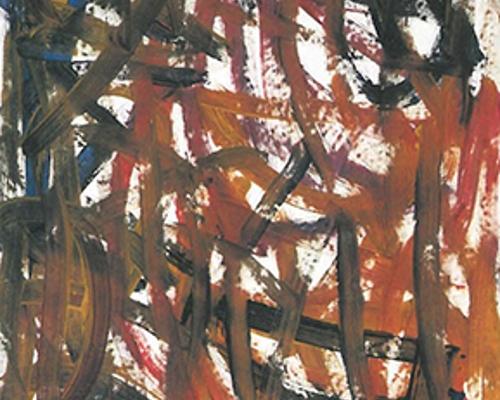
Emily Kame Kngwarray
A tribute to Emily Kame Kngwarray the celebrated painter from Sandover near the central desert community of Utopia, who died in 1996 after a meteoric career during which she produced 3,000 works in 8 years. Although her concern was to paint and thus protect her country (her main subject was the pencil yam after the seeds and flowers of which - kam - she was named) she was acclaimed by some as a major abstract painter of the 20th century. She won a major creative fellowship and was posthumously shown at the Venice Biennale.
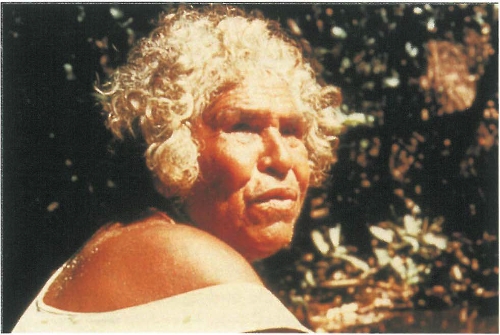
Queenie McKenzie
A tribute to the Western Australian artist Queenie McKenzie who died in 1998. She lived her whole life in the Texas Downs area and before taking up painting in old age she worked on the cattle station there and was a stalwart supporter of 'women's law business' and language. She was a confident and prolific painter mostly of her country but sometimes of social topics. When her work was recognised by the art market she shared her material success generously with her adopted family.
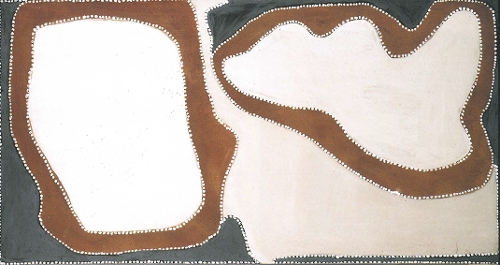
Rover Thomas
A tribute to the Western Australian artist Rover Thomas who died in 1998 aged around 72. After a full life spent as a stockman and an important leader of ceremonial life through the Kurirr-Kurirr dance cycle in the Warmun community, in 1982 he began establishing a new mode of painting based on Kimberly rock art. His bold and original painting depicts the land and the massacres that took place there up to the 1950s. The National Gallery of Australia accorded him a retrospective exhibition Roads Cross in 1994.
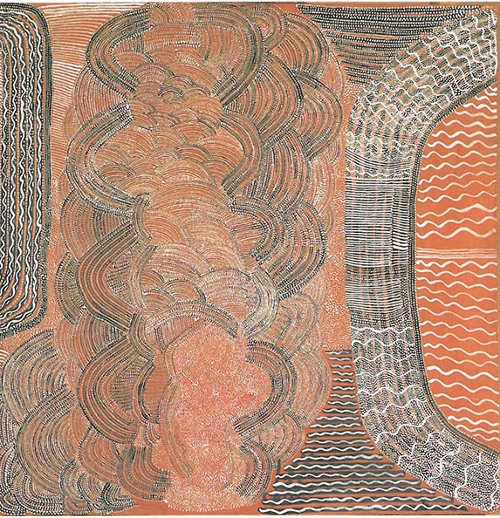
M.N. Tjapaltjarri
A tribute to Mick Namarari Tjapaltjarri born c.1926 in Pintupi country and who died in 1998. He lived in Papunya and was encouraged by Geoff Bardon to start painting and was a member of the Papunya Tula Artists Company. By 1991 when he won the National Aboriginal Art Award his works were being acquired by national collections and many other collectors.
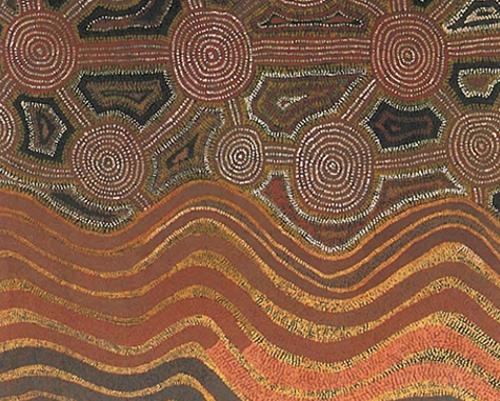
Y.Y. Gibson Tjungurrayi
A tribute to the Pintupi painter Yala Yala Gibbs Tjungurrayi born c.1928 in the region of Kintore and died in 1998. He was a strongly traditional man and after migrating to Papunya he was encouraged by Geoff Bardon to take up painting. His works, mainly the Tingari stories to do with the ceremonial stories of ancestral men, were acquired by collections in Australia and internationally.
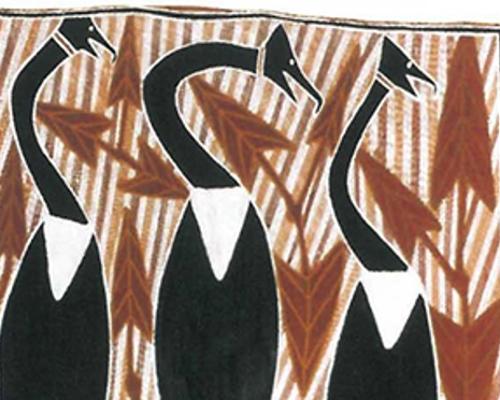
George Milpurrurru
Tributes to two painters from Ramingining in Arnhem Land, George Milpurrurru and David Malangi who helped to place this region on the map. Paintings were included in the 1979 Sydney Biennale. The iconography, style of painting and the public response to their work and interaction with the wider art world is discussed. Both of these major artists died during the 1990s after careers of around four decades.
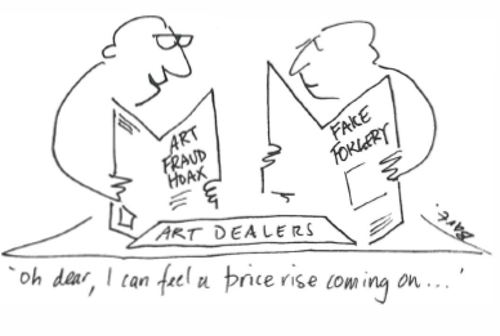
The 'Aboriginal Art Scandals' Scandal
A chronicle of a spate of so-called 'Aboriginal art scandals' which happened in the late 1990s, some of which involved white artists passing off work as Aboriginal. The custom amongst indigenous artists of family members working with an artist on paintings creates problems for the western art market and leads to claims of fraud. The media is often guilty of distorting and sensationalising events. The newly launched Label of Authenticity enters the scene.
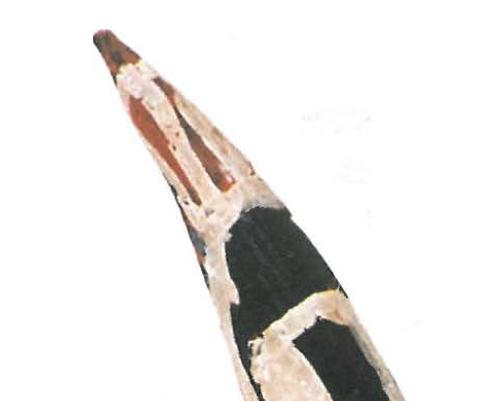
Black Glory: Erotica Old and New
The exhibition 'Love Magic' explored Aboriginal male erotica and reveals a little-known dimension in traditional spirituality which has been echoed by contemporary artists. Images of phalluses, couples embracing and testicles going walkabout refer to legends and stories of the Old People. This very large exhibition was a life-affirming spectacle with humour and poignancy as well as some powerful eroticism.
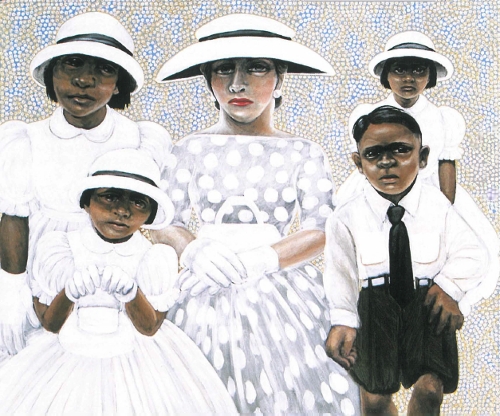
Looking at the Stolen Generation
The government policy of separating Indigenous children from their parents was still in force until the 1970s in some states. Indigenous artists who have recently begun depicting these events include Julie Dowling, Gordon Syron, John Packham, Rea and Brenda Croft. Their work has been part of the uncovering of the hidden history of these children of which many non-indigenous Australians were quite ignorant until the mid 1990s.
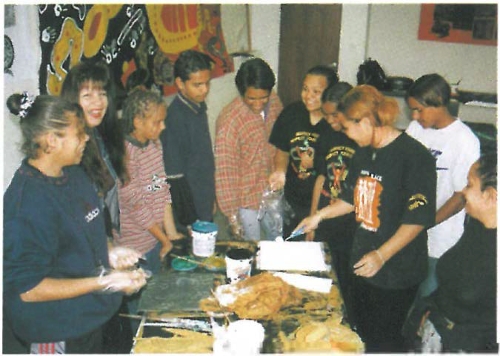
Good Brother Working with our Kids
Ron Gidgup was the first Aboriginal fashion designer in WA. Since getting the Aboriginal of the Year Award in 1997 he began to turn his skills towards helping Aboriginal youth in crisis. He runs workshops in textile and clothing design and brought many young people back from the brink of death from substance abuse. He has worked in urban and rural settings, with schools and other groups.
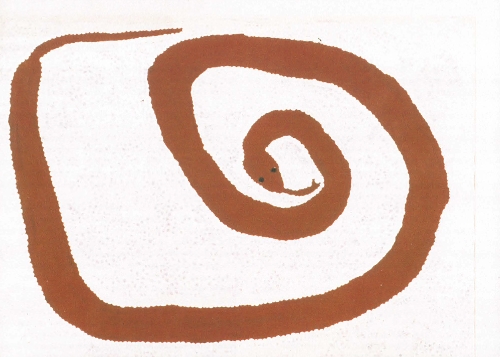
Charting Co-existence
Mapping Our Countries was an exhibition at the short-lived Djamu Gallery in Sydney, curated by artist Judy Watson and archaeologist Dr Paul Ta'on. They collected objects and works of art to illustrate how they relate to the idea of mapping land or sea. Mapping is done for a huge variety of reasons, for exploiting resources, for proving theories, for simply finding one's way.
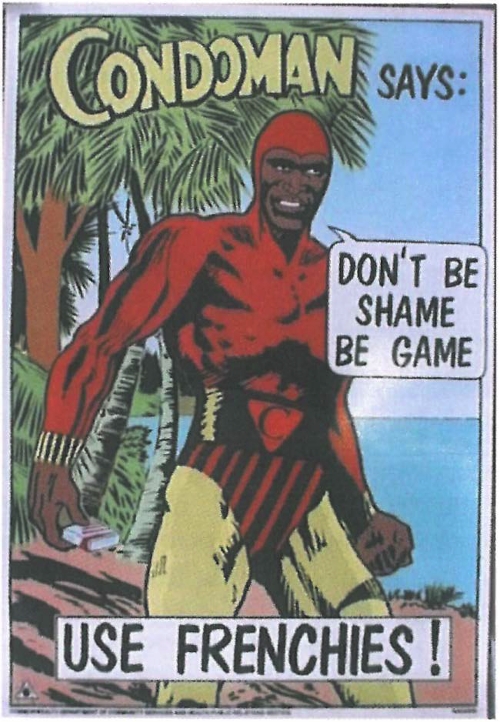
Health and Art: Can art make people (feel) well?
Art can function in a wide range of ways beyond what is normally regarded as its arena. It can empower by raising confidence, providing income which can be used to improve diet and living conditions, it can be therapeutic, liberating and provide an emotional and intellectual outlet, while posters and TV ads can convey important messages about health issues. When a culture is strong the people are healthy.
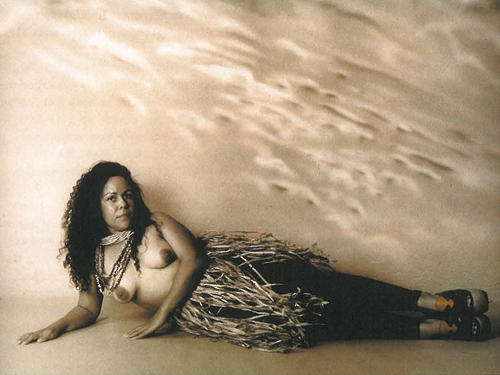
Photography with Intent
Various indigenous artists began to use photography to express ideas about their social and political position in the 1980s; the 1988 Bicentennial celebrations were a strong catalyst. Formerly they were always on the other side of the lens, as anthropological subjects. The exception was Mervyn Bishop, employed as a press photographer in the 1960s, and pioneer in the medium and role model for younger artists including Fiona Foley, Ricky Maynard, Peter McKenzie.
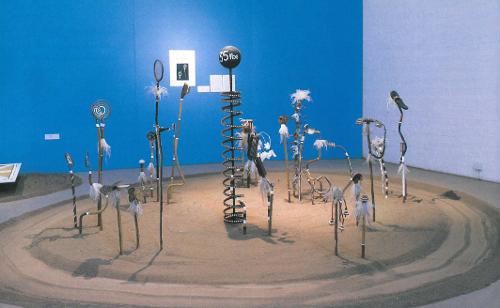
Challenging boundaries: Indigenous Art in Three Dimensions
Recent Indigenous 3-D work is regarded as both art and craft. The materials range from shell and rushes to scrap steel, grass, ceramic, glass and bull kelp; the works may be vessels, installations, necklaces, small figures etc. The works often contain explicit references to cultural or historical truths eg the figures by WA artist Joyce Winsley which recall characters from her youth in the country, or Lola Greeno's water containers made in the traditional way from bull kelp .
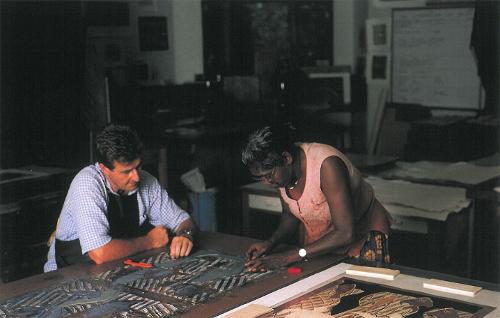
Printmaking Gains Momentum
The first Aboriginal prints were linocuts made in jail by Kevin Gilbert. By the late 1970s Aboriginal printmaking in collaboration with print studios had begun. The Canberra School of Art, Port Jackson Press and now Northern Editions have been catalysts for the many enthusiasts at the Yirrkala, Papunya, Tiwi, Munupi, Oenpelli, Ernabella etc communities and workshops are run in remote centres at their request. Some like Lockhart River are now setting up their own facilities.
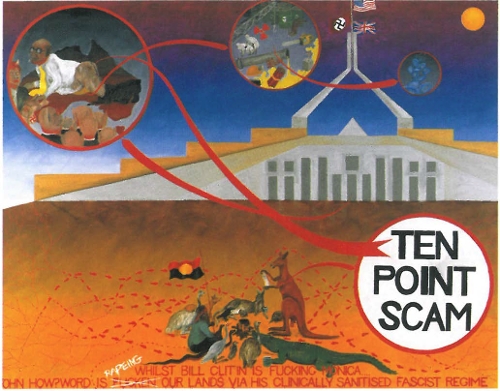
Political Theatre in Beyond the Pale
The Adelaide Biennial of Australian Artin 2000 was a survey of new indigenous art titled Beyond the Pale. This attempt to show the best of new work was staged as a series of rooms each with a different mood from baskets and shimmering paintings to rooms of confrontation where works invited viewers to be shocked by figures of authority seen in very unflattering mode.
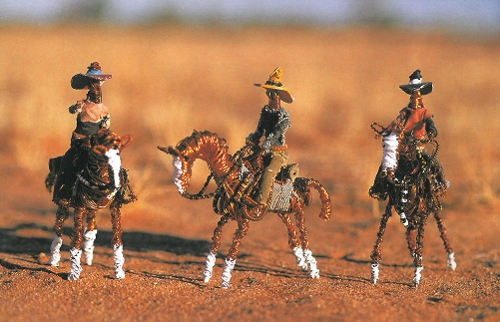
Bush Toys
Bush Toys was an exhibition of toys made from scraps of metal and copper wire by the male members of the Eastern Arrente tribe of Central Australia in the late 1990s. These recall the era when Aboriginal people were the backbone of the pastoral industry, as stockmen and horse trainers. There are miniature horses and riders, windmills and stockyards, and wooden 'cars' for children to push along or ride in. The toys are a source of great pride for the men who make them.
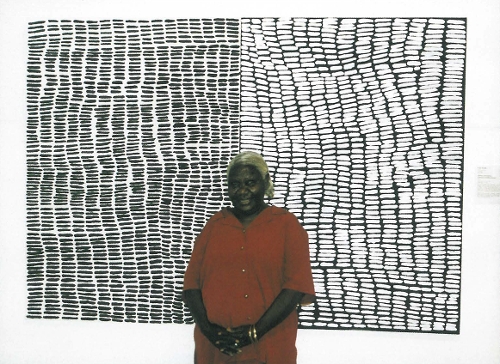
Art in Warmun community
A new art centre at Warmun in the Kimberly of WA is a showcase for the talents of the artists of the area, some of whom used to work on big pastoral stations in this remote area. Celebrated founders of the centre were Rover Thomas and Queenie Mckenzie. There are tensions between their interests and those of white landowners in relation to access to 'country' being denied. Young people are unable to have a traditional education and are becoming westernised through videos.
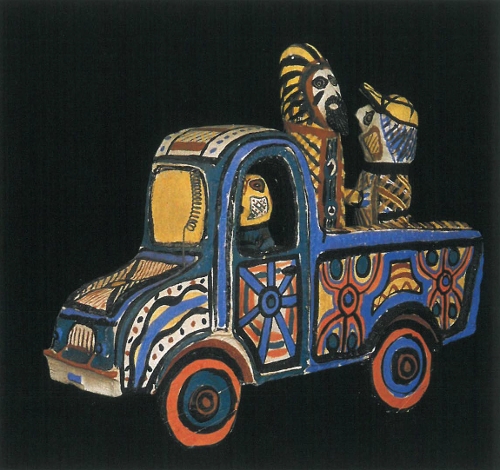
New Ways With Clay: Tiwi Pottery
The Tiwi people on Melville and Bathurst Islands just north of Darwin have a 30-year tradition of pottery. They have absorbed a range of influences from the British Michael Cardew to visiting potters from Australia or via annual workshops with a Swiss potter Claude Presset. Some pots were collaboratively done - thrown by experienced potters and decorated by local artists. Slab and coil pieces drew on artists' experience in wood carving and painting.
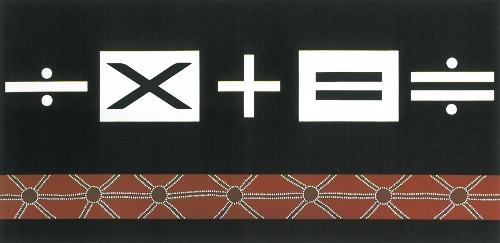
Tandanya: One City and a Festival
3SPACE -C21st Indigenous Explorers was an exhibition by Darryl Pfitzner Millika, Mark Blackman and David Pearce for the 2000 Adelaide Festival. In common is their shared history as contemporary indigenous artists in Adelaide, the city which had the first indigenous art centre Tandanya, a powerful catalyst for many enterprises which without it would not have been so well presented or widely seen.
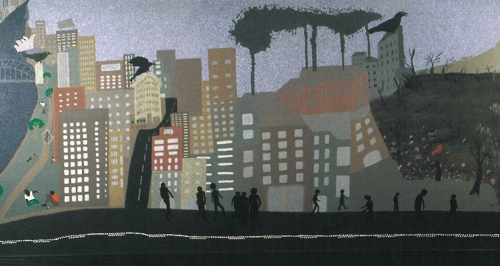
Boomalli: Fact or Fantasy: you decide!
Boomalli, founded in 1987, enters an unlikely future where anonymous benefactors help them to buy premises in an inner city suburb, to employ curators and become independent of funding bodies. Tax-free havens are set up for indigenous artists in NSW and Boomalli members exhibit regularly at MOMA in New York.
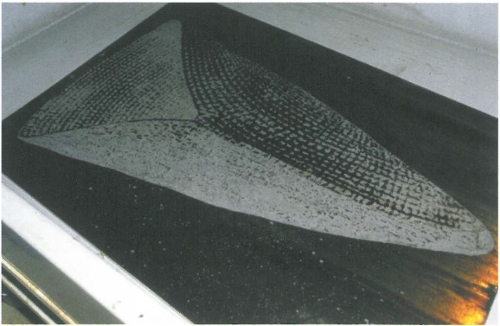
Judy Watson's etched zinc wall at Bunjilaka
Queensland artist Judy Watson spent three months in Melbourne on a commission for a zinc wall around 50 metres long for the Bunjilaka gallery at the new Museum Melbourne. Watson used motifs relating to Aboriginal material culture in the etched panels of this work.
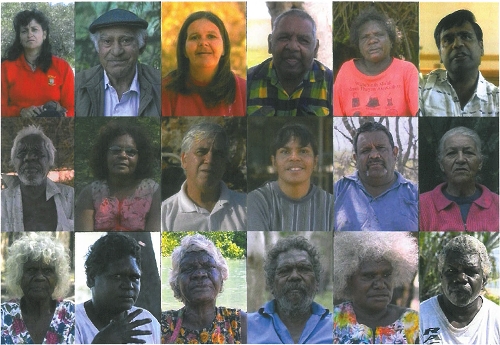
Contemporary Voices: Australian Aboriginal Cultures Gallery in the SA Museum
The new Aboriginal Cultures Gallery at the SA Museum has set a new standard of excellence in interpretation of historical material. The use of film, video and computer terminals carrying extensive information from songs and interviews to historical documentation adds to the rich texture of the displays. Contemporary Voices is a set of filmed interviews conducted by museum staff in the six months before the opening of the new Gallery
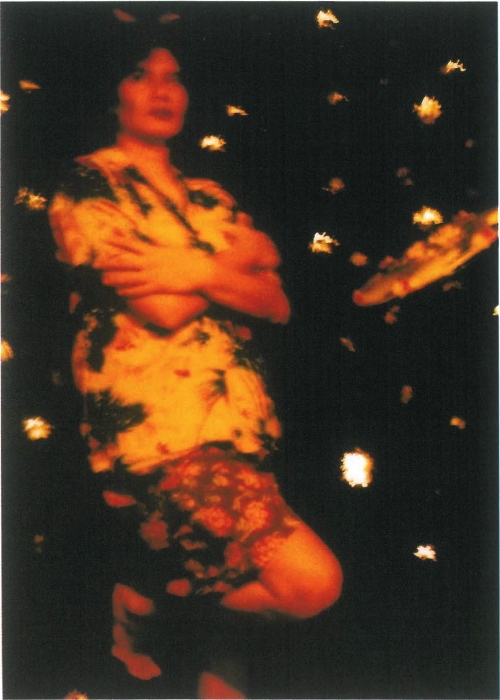
Labelled - Buyer Be Aware
The introduction of a Label of Authenticity has some problems for contemporary urban Aboriginal artists who feel once again that they are being asked to confirm their status. Another issue is that any indigenous person can apply for the Label regardless of the integrity of their art practice. Is the Label too blunt an instrument to be useful to most artists?
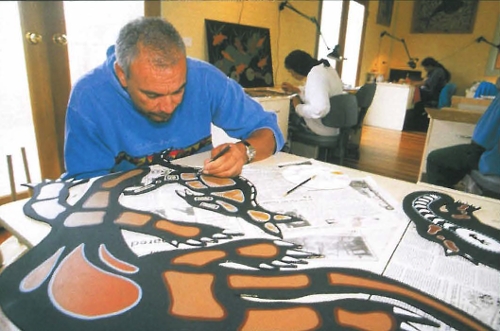
The Indigenous Visual Arts Industry: Issues and Prospects for the Next Decade
The economics of indigenous art is analysed in detail in relation to production, collection and distribution, consumption, developments in the 1990s, prospects for the next decade, tourist art, protection of intellectual property, quality control, authenticity and leadership.
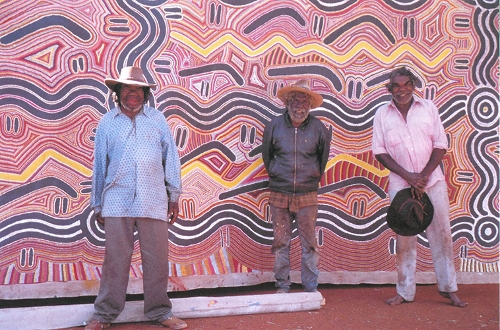
Fair Trade in Central Australia
Without regulation in a market there will always be carpetbaggers. Warlukurlangu Artists was set up by a group of artists to protect them from this. DESART, the peak body for Central Australian art producers, in 2000 has initiated a Central Australian Indigenous Art Label which aims to educate consumers and lead the way by example rather than police a market.
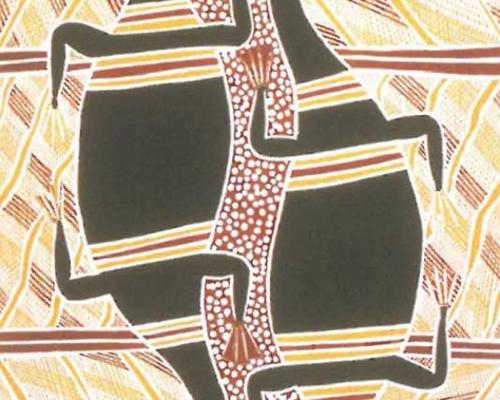
The House of Aboriginality
The House of Aboriginality is an evolving multimedia project about the merchandising of Indigenous imageries. A CD-rom sets out the story of the circulation of this in mainstream culture through the metaphor of a house entirely furnished with products bearing Aboriginal art designs.
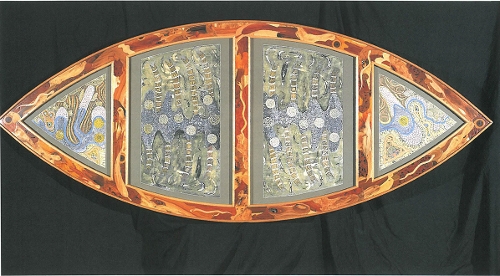
Snapshot of a Culture
A conference about Indigenous arts and crafts was held in 1999 and was a useful sounding board for issues from the new Label of Authenticity and copyright, to the new Goods and Services Tax and art in cyberspace.
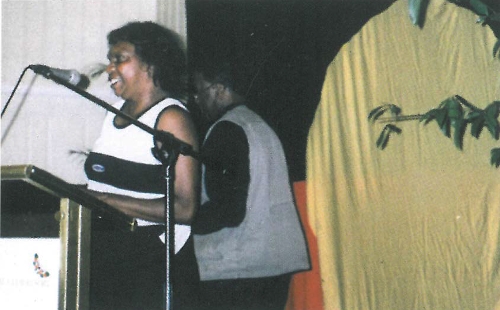
The Art and Craft Centre Story
Review of The Art and Craft Centre Story Volume I by Felicity Wright and Frances Morphy. This is an exhaustive survey of Indigenous art centres examining every aspect of their operations. The appalling conditions under which the staff of these centres work bely the extraordinary success of these centres. The authors recommend adoption of a policy of coordinated help with human resources.
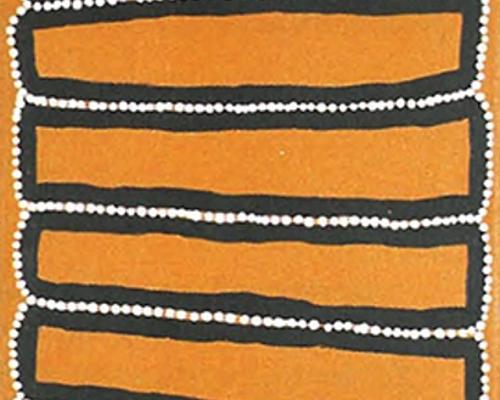
Nomad to TV star in three years: Walala Tjapaltjarri meets the world
In late 1984 Walala Tjapaltjarri and other Pintupi tribespeople walked out of the Gibson desert in WA and met Europeans for the first time. Within a few years Walala adapted his traditional ground and body painting to painting on canvas and was filmed by Robert Hughes for his TV series Beyond the Fatal Shore.
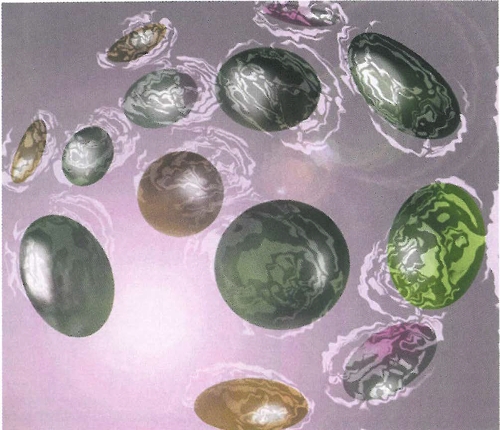
Remote Area Computer Art: Multi-Media Talent Emerges in Yuendumu
Donovan Rice is a young Warlpiri man who has virtually taught himself to make computer art in the remote community of Yuendumu. He is making digital images and animations which relate to his own cultural situation against the backdrop of a chronically disfunctional society. He works under the aegis of Warlpiri Media, a community-run media resource centre and TV production house.
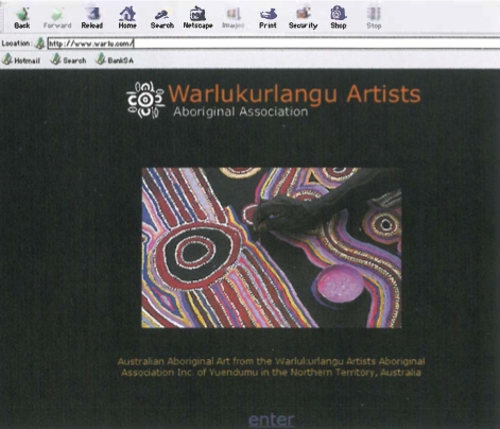
Indigenous.arts.online - Virtual Sales of Actual Art? Profit or Promotion
The obstacles to Indigenouse people selling their art on the internet are many and daunting for most. Some pioneer groups like Boomalli and Warlukurlangu Artists have web sites, but in the near future Indigenous art sales on line will be an accepted way of operating. Some web sites are listed.
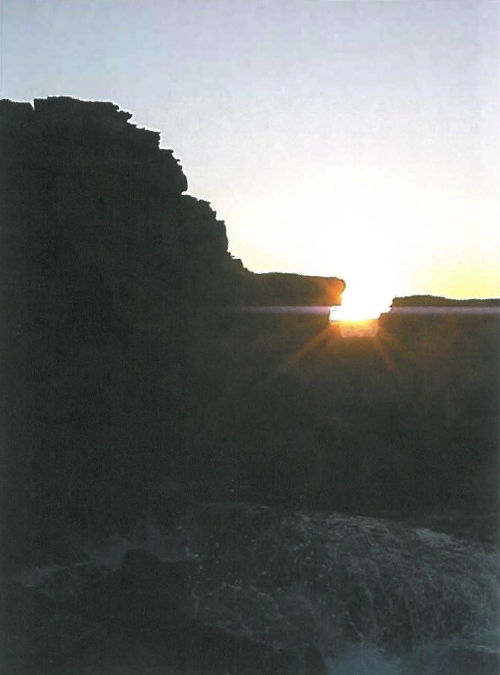
Snapshots of Contemporary Sound, Movement and Words from Broome
Broome is a town in WA with a long history of many cultures living and working together. It is the home of a vibrant Indigenous music industry, its most famous sons being the Pigram brothers and Jimmy Chi, author of the musicals Bran Nue Day and Corrugation Road . Magabala Books is flourishing, and the Stompen' Ground Festival is gaining in strength and reputation.
Darwin Festival - A Glimpse
Overview of the Festival of Darwin with its temporary visual art installations 'art head land' by 18 artists. For the summer of 1996.
Indigenous Arts of the Pacific
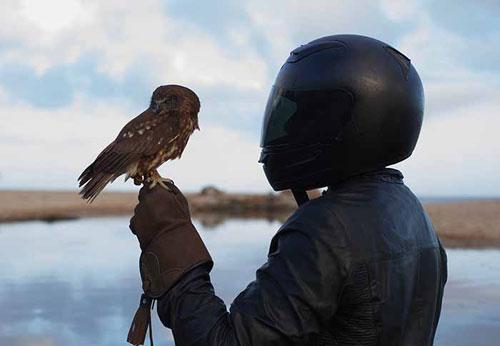
Shaun Gladwell: The Lacrima Chair; Collection+
Shaun Gladwell: The Lacrima Chair (SCAF Project 24); Collection+: Shaun Gladwell (SCAF Project 25) Sherman Contemporary Art Foundation, Paddington UNSW Galleries, Sydney
6 March – 25 April 2015
6 March – 25 April 2015
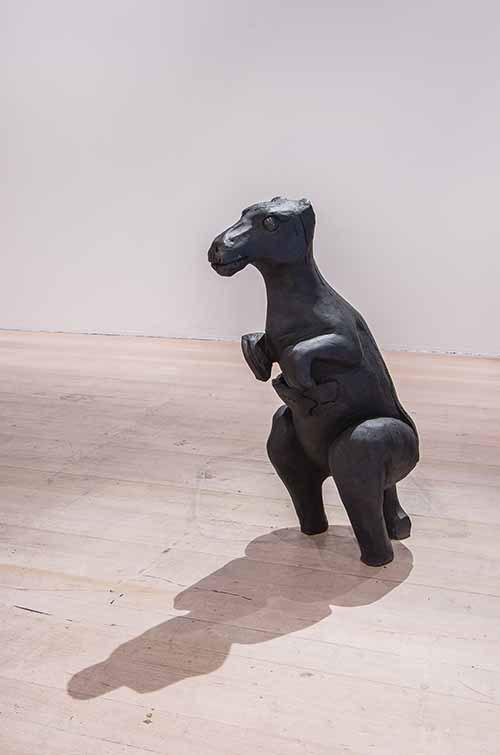
Outside Thoughts
Mitch Cairns, Emily Floyd, and Danie Mellor
Darren Sylvester Contemporary Art Tasmania, Hobart
19 March – 19 April 2015
Darren Sylvester Contemporary Art Tasmania, Hobart
19 March – 19 April 2015
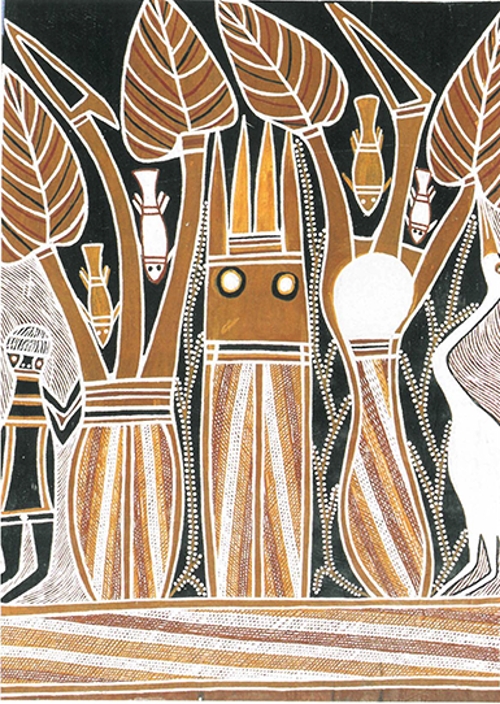
David Malangi
Tributes to two painters from Ramingining in Arnhem Land, George Milpurrurru and David Malangi who helped to place this region on the map. Paintings were included in the 1979 Sydney Biennale. The iconography, style of painting and the public response to their work and interaction with the wider art world is discussed. Both of these major artists died during the 1990s after careers of around four decades.


